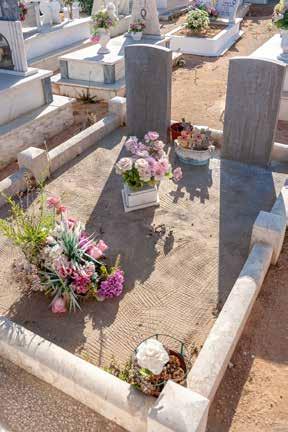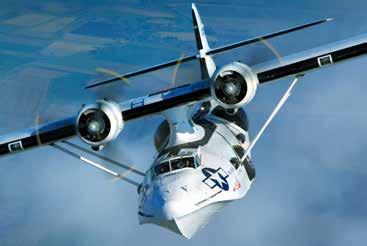
6 minute read
RAF Heroes Honoured
By Phil Egginton
On 22 March 1943, World War Two dramatically came to the Algarve. Tragically 10 RAF aircrew lost their lives, but in doing so, saved many locals in Sagres. These heroes are now being honoured.
Advertisement

A Catalina at Gibraltar during WW2, Image courtesy The Catalina Society
Anyone who visits Sagres at the far western tip of the Algarve will know it is a very beautiful place. In summer the views out to sea from the lighthouse at Cape St Vincent are spectacular. But it can be very windy. During the winter months, it may be bleak and wild. Storms can blow straight in from the Atlantic, as indeed one did on 22 March 1943. A cold front extended right over Sagres. Visibility was very poor; the cloud cover extending down almost to sea level.
Locals in Sagres reported that just before 4 p.m the sudden and loud noise of engines could be heard at Tonel Bay. People rushed out to see an aircraft emerge very low from the mist. Suddenly seeing the vertical cliffs in front of them, the aircraft lurched upwards under power. Skimming the cliff tops, the pilot was then faced with the houses of Sagres right in front of him. Struggling to keep control, the pilot turned the aircraft into a sharp bank. Some locals reported that one of the engines stuttered. The aircraft quickly lost lift, technically called a stall. It crashed down into the cliffs, exploded and disappeared below the Atlantic waves. Locals including fishermen, rushed to help the crew. Sadly, only two bodies were recovered. The other eight crew remaining, to this day, beneath the waves at Tonel Bay. Aircraft Corporation at San Diego, California being handed to the RAF in July 1942. It arrived with 210 squadron in Gibraltar in late 1942.
The crew of 10 consisted of Flying Officer M.J.French who was first pilot and commanded the plane. He had Sergeant E.McKim as second pilot, Pilot Officer G.E.McNaughton (an Australian) who was navigator, Flight Sergeant R.J.Campbell and Sergeants C.Field, G.J.Orton, G.Gibson, E.J.Smith, E.H.S.March and I.L.McLean as flight engineers, weapons operators and air gunners. French and his crew had taken off from Gibraltar at 8.12 a.m on an anti-submarine patrol off Cape St Vincent. The Gibraltar base radioed them to return at 3.23 p.m which they acknowledged. Tragically they crashed only 19 minutes later at 3.42 p.m. The bodies of Sergeants Gibson and Orton were recovered. George Gibson came from Lockerbie in Scotland, he was 23. Gilbert Orton came from Birmingham, he was 21 years of age when he died. They were buried with full military honours in Sagres municipal cemetery. Their well-tended graves, with Commonwealth War Graves headstones, can be visited today at Sagres cemetery just off the N268. The crew were all young men, the oldest being only 31 years of age.
The aircraft was a Catalina of 210 squadron, RAF Coastal Command. The aircraft carried the squadron code letter D. A detachment of 210 squadron had been sent to Gibraltar in 1942. Convoys from the UK to the Mediterranean were being harassed by German submarines (U-Boats). The Catalina was a flying boat with radar, special searchlights and anti-submarine weapons. Catalina D was built by the Consolidated On 9 April 2019, Vila do Bispo council inaugurated a monument (Monumento de Homenagem aos Combatentes) in memory of local servicemen. The council included the names of the Catalina crew in homage to their sacrifice in saving local lives. Clive Jewell, the British consul and Peter Rayner, the Australian ambassador to Portugal attended.

The graves of Sergeants Gibson and Orton at Sagres today, image by Phil Egginton
Lagos based expat Mike Pease was instrumental in this homage. My own interest was sparked upon hearing of the Vila do Bispo monument. I met with Mike and discovered he was attempting to trace relatives of the crew to let them know about the monument. Some limited contact had been made with families in the UK. I offered to help, and through a well-known family history website, I managed to track down the family of Pilot Officer George McNaughton and contacted his nephew, Don Taylor. George died at the young age of 25.
George and his sisters lived in Caulfield, Melbourne, Victoria. Caulfield today is the home of the popular TV soap, Neighbours. Extensive records exist in the Australian national archives relating to George. These include the original RAF investigation report written by the 210 squadron flight commander on 27 March 1943. This reveals that the pilots had little experience of flying using only instruments and the aircraft navigational aids may have been out of service. The report concludes "An unfortunate accident probably due to the inexperience of the pilot as Captain of an aircraft".

George McNaughton the Australian Navigator, Image courtesy Don Taylor
The archive documentation includes copies of the very moving telegram received by the family on 25 March 1943 informing them, "Deeply regret to inform you that your son pilot officer George Ericksen McNaughton is missing and believed to have lost his life as a result of air operations on 22 March 1943". George’s personal effects were collected and sent back to the family. They were signed for by his sisters, including Don´s mother. As well as the expected clothes it lists items such as a Kodak Bantam camera, a pair of ice skates, 31 photos, a table tennis ball, a chrome cigarette case and a membership card for the Boomerang Club. George trained to be a navigator at Pennfield Ridge air navigation school on the east coast of Canada. Don told me, "George's death had a profound effect on my mother. Even though I see from the records that she and my aunt were fully informed, she spoke about it to me and my sisters only in very general terms.
" I would like to thank Don Taylor and his family for letting me share the personal information and photo of George. I also want to thank David Legg, editor of the Catalina News of the UK based Catalina Society. They maintain a flying Catalina at Duxford near Cambridge. David provided much of the technical details and squadron history for me. Finally, thanks to Konstantinos Alexandropoulos, Communications Executive of the Commonwealth War Graves Commission.
Mike Pease is now planning to present an artist’s impression of the incident to Vila do Bispo council as thanks for them honouring the crew on their monument. Plans are well advanced, and an artist has been engaged. This will also cement the good relations between the UK and Portugal that have existed for centuries. Anyone wishing to contribute to the costs of this are asked to contact Mike by email, on mikepease@sapo.pt
We will cover the sketch and its presentation in a future edition.
+INFO:
www.catalina.org.uk (The Catalina Society)
www.cwgc.org (Commonwealth War Graves Commission)
Did you know...

Catalina today, Image courtesy The Catalina Society
The PBY Catalina series of flying boats was originally conceived to meet a military requirement and its development built on Consolidated’s experience with earlier flying boat designs. It was one of the most widely used seaplanes of World War II.
As the war progressed, Aircraft manufactured in the US were supplied not only to the US forces and the Royal Air Force but also to the Royal Australian Air Force, Royal Canadian Air Force, Netherlands Navy and Royal New Zealand Air Force.
After the war, Catalina planes were used for aerial surveys, due to their ability to fly steadily for long periods. The other role was aerial firefighting and Portugal had one of the last Catalinas to be used in this role.


